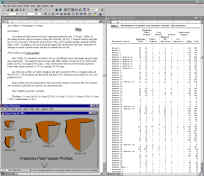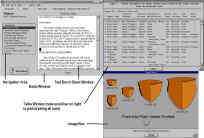
 |
The CD reviewed elsewhere in this issue of the Newsletter, Excavating Occaneechi Town: Archaeology of an Eighteenth-Century Indian Village in North Carolina, is a superb example of an excavation report in electronic form. It does a very good job of presenting the information, and it provides complete access to the excavation records as well.
A question remains, however. Should any excavation report be published on a CD or in any other electronic form? Technophiles like the writer are supposed to answer such a question with a resounding "Yes!" In truth, however, the answer to that question is not a simple one, and, in fact, there may not be a single answer. I would like to suggest some other questions that may help lead to an answer-or answers.
First, are there some specific advantages to an electronic publication of the project at hand? What are the potential gains over a book?
Second, is the material presented with the aid of specific computers, programs, and/or presentation schemes? That is, does access to the information depend on current computer hardware or software?
Third, does the way the report looks on screen-the use of windows, the placement of items relative to one another, the use of animation or sound-make a major difference? Ought the "look and feel" to be preserved?
The answer to the first question, of course, depends on the nature of the project, the kinds of data available, the plans of the author/editor, and the software to be used. Cost and speed may also be considerations, but they should be secondary considerations. In the case of Excavating Occaneechi Town, the authors/ editors obviously had specific advantages of electronic publication clearly in mind when they chose to publish electronically.
For the second and third questions, the point is the overriding issue of permanence. An excavation report should never disappear. We cannot afford to waste the time, the effort, the expense, or the site by allowing what we have learned to disappear into the mists. But we know that computer hardware and software will change, possibly threatening access to the information. Therefore, we must concern ourselves with all the issues that may affect permanence.
There are two separate issues, though, regarding permanence. One is the permanence of the underlying information; the other is the permanence of the presentation, the "look and feel" of the author's way of using the data and making the arguments. The details of the presentation may not be important, but the juxtaposition of text, images, and other supporting information will be as necessary for a user trying to follow the arguments and factual issues in 50 years as for a contemporary user.
Here again, Excavating Occaneechi Town serves as a good example; permanence is as nearly guaranteed as possible. The data files are being archived at the ADAP, along with the documentation, and the files include all the raw data as well as the text, maps, and photos. They will be available permanently through the archive, and their form will be modified as necessary to guarantee continue access.
What about the presentation? It does depend on software and hardware; in this instance, the user need not own the software separately, but the CD does require a PC rather than a MAC, and self-contained software will drive the presentation. Fortunately, the authors/editors have been remarkably far-sighted in providing alternate ways to access the same information via open, standard document types. As a result, one may, without specific software or hardware, find the text, each image, each link to a table, each map, and so on with standard files (in multiple formats)-and the juxtaposition of text and supporting material is always explicit. That is, without the presentation software one can essentially duplicate the form of the arguments-text with supporting maps, photos, and tables-on any modern computer. The appearance and functionality of the presentation-windows, point-and-click hyperlinks, and so on-are not available without the presentation software, but the crucial argumentation is. (See Fig. 1 for a view of a computer screen with the same information as shown in Fig. 2(1) but using a word processor and an image editing program.)
 |
 |
| Fig. 1 | Fig. 2 |
Fig. 1 is a reduced view of a portion of a computer monitor with data from the Occaneechi Town CD, the same data shown in here in Fig. 2 but here displayed with a word processor (Microsoft® Word) and an image editing program (PhotoShop®) instead of the multi-media program used for the CD presentation.
The authors/editors of the Occaneechi Town CD have provided, then, a thorough presentation of their data on a CD that is limited as to computer hardware and software today. At the same time, however, they have provided the essentials of the argument (including all the data and supporting information) in a form that is machine- and software-independent. Finally, they have seen to the archiving of all so that permanence can be assured.
The only missing piece is the form of the presentation itself. The windowing system with hyperlinks is available only for specific hardware running specific software. Does that matter? In this case, it surely does not. The point is not the aesthetics of the system but the quality of the argument and the cogency of the supporting data. That is generally the case with scholarly material.
This CD, then, deserves the technophile's resounding "Yes!" to the question about e-publishing The authors/editors have not only provided a superb tool that uses electronic access to advantage; they have also made sure the tool will continue to work into the distant future so long as proper archival protection is provided-and they have seen to that as well by sending the files and documentation to the Archaeological Data Archive Project.
If there were some need to preserve the "look and feel" of the Occaneechi Town CD, the possibilities would be different. The ADAP would then need to maintain the multi-media software and migrate the entire system over the years. Even if that migration were accomplished, computers of the future-with new operating systems, better speed, improved graphics, and so on-would not accurately reflect the original presentation (2).
The questions posed at the outset have helped clarify the issues at stake when the advisability of e-publishing is considered. A good electronic publication on the Web or on CD should provide a superior presentation of arguments and data. In addition, access to arguments and supporting data should be ultimately independent of hardware and software. That access should be to the full range of supporting data. Fidelity to the original presentation system, however, is not necessary.
How many CDs or Internet-based electronic publications will be prepared with the far-sighted approach of the editors of the Occaneechi Town CD? It is impossible to know, but the extra time and trouble are significant. Those who are prepared to create good electronic presentation but not to take the necessary extra steps required for permanence should not venture into the e-publishing world. Those who are willing to invest the extra time and effort should take the Occaneechi Town CD as a model. It shows clearly that it is, indeed, possible to publish well in an electronic format and to be sure that everything-the facts, the interpretations, and even the important aspects of the presentation-survives.
(1) Fig. 2 is also seen as Fig. 1 in Review of Excavating Occaneechi Town: Archaeology of an Eighteenth-Century Indian Village in North Carolina in this issue of the Newsletter. Return to body.
(2) It will surely be possible to migrate virtually all files to new formats indefinitely, but the changes in hardware and software will make presentation from those files in the future aesthetically very different from a presentation today. Given such problems and the fact that archaeological publications and data will be archived for their content rather than their appearance, the ADAP will not normally concern itself with attempts to maintain presentation schemes or appearances. Return to body.
For other Newsletter articles concerning the use of electronic media in the humanities or electronic publishing, consult the Subject index.
Next Article: Ethical Responsibilities?
Table of Contents for the Winter, 1999 issue of the CSA Newsletter (Vol. XI, no. 3)
 Table of Contents for all CSA Newsletter issues on the Web
Table of Contents for all CSA Newsletter issues on the Web